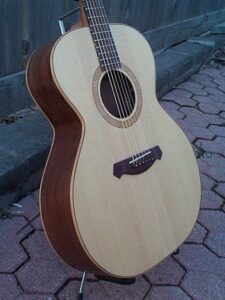Birth of a luthier

I began building my first acoustic guitar in 2000. It was slow going. Not only did I have to research each step of the process but I also had to build a number of the required jigs and specialty tools as well. I stuck with it though and after nine or ten months that guitar was finally completed and I was hooked.
In the years since then, I’ve built many guitars, taken a break as life and other interests got in the way, and eventually picked it up and fell in love with the process all over again.
I enjoy developing new ideas. Over the years, I’ve continued to refine my building process as I figure out what works for me and what doesn’t. I build only a few instruments each year and purposely make a point to not repeatedly build the same thing. That keeps it exciting for me and helps to insure that each instrument I make is an interesting creation.
Soundboard bracing
Most steel string acoustic guitars being made today use some variation of an X brace system originally created by C F Martin in the 1840’s. Traditionally, guitar tops have a sound hole, roughly 4 inches in diameter, just above the waist and right in the path of where the string tension is trying to fold the guitar in half. To compensate for the empty space, bracing structure is typically built around and above the hole to support and reinforce the top. This additional structure adds weight and rigidity to the upper part of the soundboard, restricting it’s ability to vibrate and contribute to the generation of sound.
In the late 1990’s and into the early 2000’s, there was a smallish musical instrument company based in Washington state called Tacoma Guitars. The company was eventually swallowed up by Fender and has long since stopped producing instruments, but during their heyday, Tacoma produced some interesting acoustic guitars using a non-traditional, minimalist approach to bracing and adornments. Several of their models sported a sound hole in the guitars upper bout. The Tacoma guitars were perhaps not terribly well made, but several of the ideas that they incorporated intrigued me and have had an influence on the design of some of my instruments.
By moving the sound hole away from it’s traditional location on the guitars centre line, some of the surrounding bracing structure can be eliminated. The theory is that this frees the upper portion of the soundboard to more easily vibrate and contribute to sound production. Relocation of the sound hole also opens the door to new options in placement and rotation of the main structural X braces.
Sound hole location
Once you’ve decided to move the sound hole from it’s traditional location, the question becomes where to put it? Over the years, many smart people have written volumes on the physics of sound production by a complex system like a guitar soundboard. A lot of it, I don’t even pretend to understand. However, locating the sound hole closer to the fretboard end of the body does lower the internal Helmhotz resonant frequency of the sound box. Multiple sound holes, including side mounted sound ports, seem to work as well as a large single hole. In practice, I continue to experiment with the placement and number of sound holes, discovering what both works well sonically and is aesthetically pleasing at the same time.
Inside access
One advantage of having a large centre sound hole is that it provides ready access to the inside of the guitar should it ever become necessary to affect repairs, install or replace a pickup, etc. For guitars that don’t have a traditional centre sound hole, I’ve developed a system that incorporates an access port in the guitars tail block. An access panel that plugs the hole is secured in place using the end pin jack.
A Practical Example
So what effect does different sound hole placements or using the asymmetrical X bracing make? Read about ”The Butternut Twins” for a practical example.